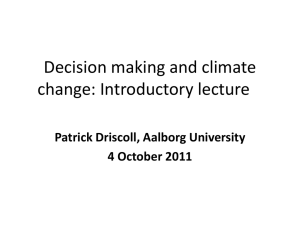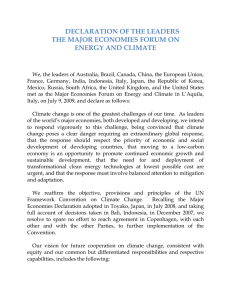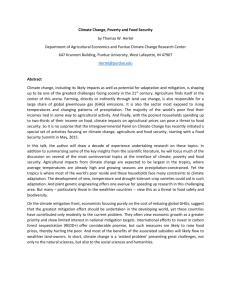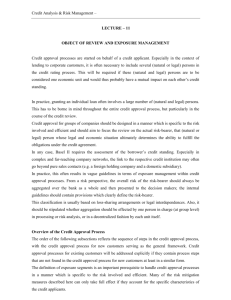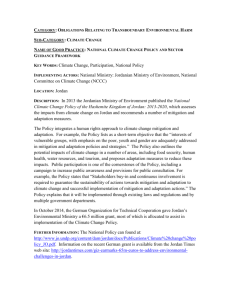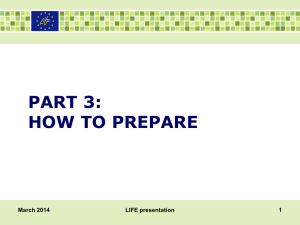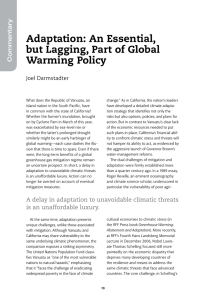T Dear Mr. President and Members of Congress, Climate Change Policy
advertisement
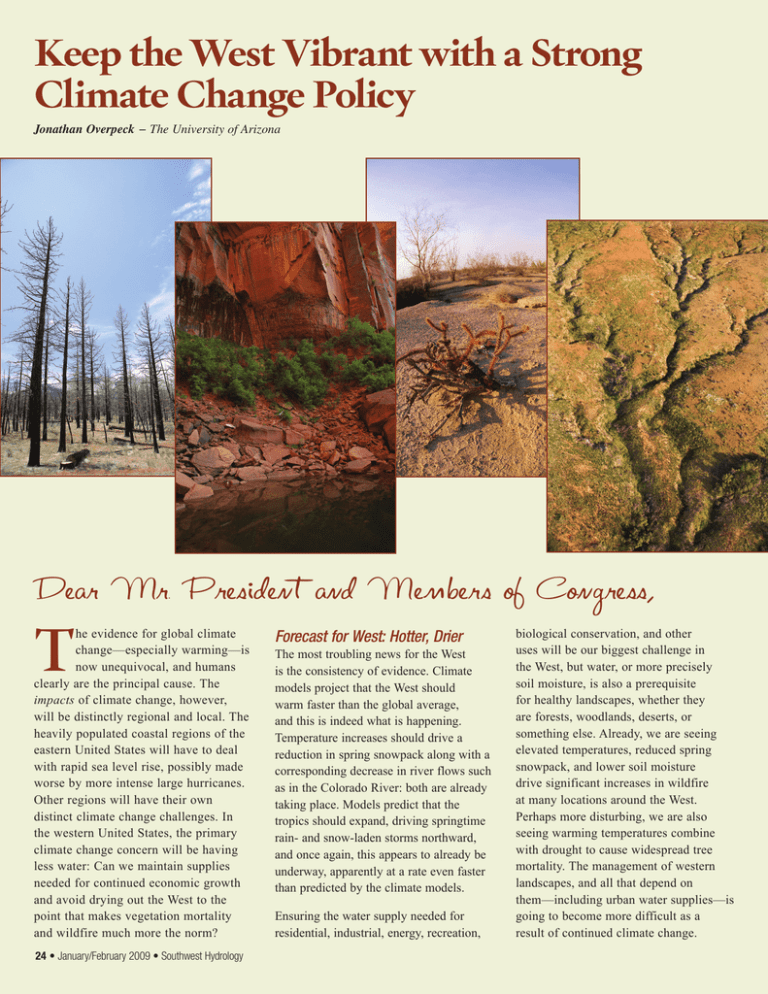
Keep the West Vibrant with a Strong Climate Change Policy Jonathan Overpeck − The University of Arizona Dear Mr. President and Members of Congress, T he evidence for global climate change—especially warming—is now unequivocal, and humans clearly are the principal cause. The impacts of climate change, however, will be distinctly regional and local. The heavily populated coastal regions of the eastern United States will have to deal with rapid sea level rise, possibly made worse by more intense large hurricanes. Other regions will have their own distinct climate change challenges. In the western United States, the primary climate change concern will be having less water: Can we maintain supplies needed for continued economic growth and avoid drying out the West to the point that makes vegetation mortality and wildfire much more the norm? 24 • January/February 2009 • Southwest Hydrology Forecast for West: Hotter, Drier The most troubling news for the West is the consistency of evidence. Climate models project that the West should warm faster than the global average, and this is indeed what is happening. Temperature increases should drive a reduction in spring snowpack along with a corresponding decrease in river flows such as in the Colorado River: both are already taking place. Models predict that the tropics should expand, driving springtime rain- and snow-laden storms northward, and once again, this appears to already be underway, apparently at a rate even faster than predicted by the climate models. Ensuring the water supply needed for residential, industrial, energy, recreation, biological conservation, and other uses will be our biggest challenge in the West, but water, or more precisely soil moisture, is also a prerequisite for healthy landscapes, whether they are forests, woodlands, deserts, or something else. Already, we are seeing elevated temperatures, reduced spring snowpack, and lower soil moisture drive significant increases in wildfire at many locations around the West. Perhaps more disturbing, we are also seeing warming temperatures combine with drought to cause widespread tree mortality. The management of western landscapes, and all that depend on them—including urban water supplies—is going to become more difficult as a result of continued climate change. For all the consistency between climate model projections and recent observed climate change in the West, major uncertainties remain. To what extent are the recent observed changes, and their surprising rapidity in particular, due to natural climate variability versus the anthropogenic trends on which this variability is superimposed? How large, ultimately, will the warming and drying be? Some models predict double the warming of others. Climate theory and models also point to more future drought and, paradoxically, floods as well. Could we be in for decades-long “megadroughts” like those that had profound Mitigation alone, no matter how aggressive, will not be enough. Too much change is already in the pipeline because of past and ongoing emissions. human impacts in the Southwest during medieval times, only much hotter this time around? What will the summer monsoon do in the future? Might more summer rainfall include the mixed blessing of more frequent flooding? What climate surprises may lurk in our future? Clearly, action is needed, but what form should it take? The longer we wait to act, the more carbon dioxide will remain in the atmosphere for decades, centuries, and longer, and the more future warming and drying will become inevitable for the West. Mitigation and Adaptation are Key Two broad—and interconnected—types of action are urgently required: mitigation and adaptation. First, we must leave no technological stone unturned (see table) as we work to limit greenhouse gas emissions to levels that will preclude dangerous future climate-change impacts. Many climate scientists and climate policy experts alike favor a goal of reducing greenhouse gas emissions by 2050 so that they are at least 80 percent below those of 1990. This goal is more Change in Soil Moisture Drier - + Wetter Changes in annual soil moisture (left) and maximum number of consecutive dry days (below) projected to occur by the late 21st century, based on the average of many global climate models. Stippling denotes areas of greater model agreement. Together these projections indicate that much of the West, and particularly the Southwest, will likely become drier and more drought-prone as global climate change continues, a tendency that will be exacerbated by continued warming in the region. Figures adapted from IPCC (2007). ambitious than what emerged during the recent presidential campaign or has been suggested by Congress, but conversely, even this goal could ultimately be insufficient to forestall major impacts like polar ice-sheet melting, major sealevel rise, or a level of desertification that threatens sustained economic growth and quality of life in parts of the West. The most important point is that the United States—and the world—has to quickly set some aggressive greenhousegas emission-reduction targets and then implement policy to ensure the targets are met. Changes can be made in the future as the ultimate course of global and regional climate change becomes clearer. Second, we must figure out how to adapt to the climate change that will happen no matter what we do; indeed, climate change due to greenhouse gases already in the atmosphere could drive change that is double what we’ve already seen take place. Mitigation alone, no matter how aggressive, will not be enough. Too much change is already in the pipeline because of past and ongoing emissions. Moreover, few mitigation options can be implemented without considering the possible adaptation trade-offs that could be involved. For example, all forms of energy production require water that might be needed for other uses in adapting to climate change, and these energy requirements must be factored into efforts to ensure the water supply. Many forms of future energy production (especially solar, wind, and bioenergy) could also compete for land that could be used for other purposes, Dry Days Fewer - + More such as urban growth, food generation, biological conservation, and recreation. Stakeholder/Academic Partnerships To be successful—and most costeffective—climate change mitigation and adaptation must be coupled at the regional to local scales where they really happen, and must ultimately be driven by the regional to local stakeholders who are central to bringing about change. Public see Climate Change, page 30 Energy technologies that can reduce carbon emissions to the atmosphere Reduction in energy need: • enhanced energy efficiency • enhanced conservation of energy • • • • • • Low-carbon energy generated by: wind solar hydropower hydrocarbon with carbon capture bioenergy nuclear Transportation energy generated from: • biofuels • electricity generated with the above low-carbon technologies • hydrogen generated with the above low-carbon technologies January/February 2009 • Southwest Hydrology • 25 universities have the most successful track record in working with diverse groups of stakeholders in their regions, and also in forming successful working partnerships with all the other key players: local, state, and federal agencies; the private sector; nongovernmental players; tribes; and relevant international partners. to speed up research and application—a challenge that requires both the cuttingedge research capabilities and stakeholder partnerships at which universities excel. Lastly, successful climate change adaptation and mitigation will need a rapid build-out of a next-generation workforce, and this can only happen in large stakeholder-oriented universities. economy. Opportunities realized could be just as important as the threats that are diminished, and the former could quite possibly pay for the latter. Failure to act quickly and aggressively on climate change could cede economic opportunity just as it could cripple prospects for sustained economic growth and a vibrant quality of life in the West. Stakeholders and their university partners should also be front and center in any integrated climate change adaptation and mitigation program for three other very important reasons. First, the successful program must be designed to learn and shift strategies on the go, and only at universities do we have the disciplinary and interdisciplinary critical mass, as well as a sufficiently broad workforce, to make large routine shifts in focus. Second, rapid innovation will be needed The advantages of an aggressive U.S. climate change adaptation and mitigation program go beyond saving our own skin. The technologies and knowledge systems required for successful adaptation and mitigation will be in demand worldwide, and thus aggressive action could propel the United States—and those regions of the United States most threatened by climate change—to be global market leaders in this rapidly expanding sector of an increasingly intertwined global Jonathan Overpeck is co-director of the Institute for Environment and Society at the University of Arizona, where he is also a professor of geosciences and of atmospheric sciences. He was a coordinating lead author of the Nobel Peace Prize-winning 2007 Intergovernmental Panel on Climate Change Report. Contact him at jto@u.arizona.edu. Climate Change, continued from page 25 30 • January/February 2009 • Southwest Hydrology Reference IPCC, 2007. Climate Change 2007: The Physical Science Basis. Contribution of Working Group I to the Fourth Assessment Report of the Intergovernmental Panel on Climate Change, ed. by Solomon, S., D. Qin, M. Manning, Z. Chen, M. Marquis, K. B. Averyt, T. M., and H. L. Miller. Cambridge University Press, Cambridge, 996 p.
